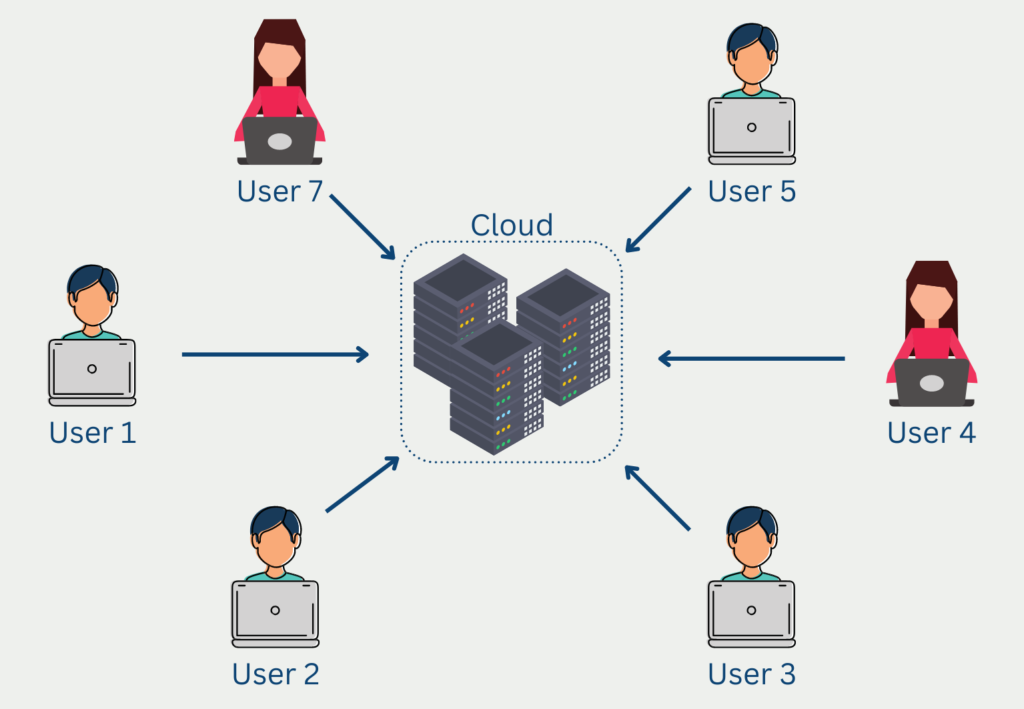A cloud is the abbreviation for cloud computing and stands for storage, computing power, or software products that can be used even though they are not available on the local computer. A connection is established via the Internet to one or more remote computers whose memory can then be used, for example, for a fee.
How does the Cloud work?
Only a few years ago, when computers were not yet so widespread, it was quite normal for several users to be created on one computer. In it, the various people in a household stored their files or installed programs. Although all the pictures from the different users were physically stored on one computer, without the password of the others, the users only had access to their own pictures. Thus, if a father did not know his daughter’s password, he could not view her user’s pictures even though they were on the same computer.

The principle of cloud computing works in a similar way, at least in the storage area. Here, many different users use one or more devices that they can access via the Internet. Although their data may be on a computer, they can only view their own information, since information about users is protected.
Why do you need a Cloud?
In the early days of the cloud, the term was mainly associated with the purchase of additional storage space, as this was the main use at the time. Nowadays, however, we encounter the concept in a wide variety of applications.
In addition to the use of memory, other applications are also conceivable. It is also possible to obtain specific computing power from providers, for example, to train a Machine Learning model that would otherwise take many times longer on the user’s own computer. There is also software that can only be used via Internet access and no longer needs to be installed locally.
What are the types of Cloud?
Cloud services are generally differentiated according to their organizational form, i.e. on the one hand who is responsible for maintaining the infrastructure and also which persons have access to it. A distinction is made between the following types:
- Public: A public cloud is a product that can be made available and used centrally by a large number of people via the Internet. These services are usually billed using a subscription model, but use can also be free to a certain extent. Classic examples from the public sector are Google Docs or the offerings from Microsoft Azure and Apple.
- Private: For companies and organizations, the use of publicly accessible programs is often an acute security risk that should not be taken, especially with sensitive data. This is why they rely on so-called private clouds. Here, the internal IT departments manage the infrastructure provided and only the circle of employees is granted access to the resources.
- Hybrid: While the public model has major security gaps, the private model is usually expensive to maintain and is only worthwhile for companies of a certain size. That is why many use the so-called hybrid cloud, which combines the best of both worlds. The applications that are particularly critical are provided internally, while less critical data can be outsourced to public providers.
What are the types of Cloud service models?
Service models are the ways in which a provider can make computing power or similar available, which the user then makes use of. The opposite of these service models is so-called on-site or on-premise software. Here, the responsibility for the operation, the data, the servers, and much more lies with the organization that ultimately uses the system. Although this architecture entails a lot of work and responsibility, some companies still rely on this approach because it ensures that sensitive data does not leave the company.
With Infrastructure as a Service (IaaS), the management of servers, data storage, and networks is handled by an external provider in the cloud. The customer, on the other hand, accesses and uses the leased infrastructure via an interface. However, the user retains responsibility for the rest of the system, for example, the applications, data, or operating system. This also means that the user bears full responsibility for possible failures or repairs.

The next stage is Platform as a Service (PaaS), in which both the infrastructure and the software platform are made available in the provider’s cloud. This option is used, for example, when applications are to be programmed. It is comparable to a virtual machine, which is provided by the provider. The user still has control over the installed programs, but all other responsibility lies with the provider.
The last stage in this structure is finally Software as a Service (SaaS), in which all previous stages and also the software itself are operated by the provider in the cloud.
Which are the best Cloud Providers?
In terms of storage usage, my personal ranking of the most popular cloud providers looks like this:
- Google Drive: In the free version, Google Drive offers the largest storage capacity of 15 GB in comparison. It also allows you to work on files simultaneously without any problems, which is why it is particularly well-suited for projects, such as presentations or shared papers, where several people always need to access the latest file status. However, Google Drive only offers limited compatibility with some Microsoft Office programs, which can get in the way of daily work.
- Microsoft OneDrive: Although OneDrive only offers 5 GB of storage space in the free version, it has a very strong price-performance ratio in the individual subscription levels. Additionally, it is of course perfectly compatible with all Office programs and is suitable when using Windows devices.
- Apple iCloud: The Apple iCloud is very comparable to OneDrive in terms of performance and is an absolute must for many Apple users. The iCloud enables smooth interaction between the various devices from the Apple universe. Actually, iCloud and OneDrive share second place. The distinction really just depends on which brand you prefer.
- Dropbox: In this comparison, Dropbox occupies one of the back places with 2 GB of free storage. However, the bedrock in the field of cloud storage usage still offers good functionalities, especially in the field of security, and thus represents a good system for backup creation.
- Amazon Drive: Amazon now also offers the possibility to use storage via Amazon Drive. As with the competitors, a free storage of 5 GB is included. Amazon Prime customers can also store unlimited pictures in the cloud.
On-Premise vs. Cloud
Since on-premises and cloud are two very contrasting concepts, it is worth taking a closer look at the advantages and disadvantages of one system over the other. The advantages of on-premises are in most cases also the disadvantages of on-premises and vice versa.
In recent years, data protection has become increasingly important. With on-premises applications, internal data does not leave the company’s internal networks. This ensures that no outsider can access sensitive data unless they gain unauthorized access to the network. In a cloud environment, however, some sensitive data leaves the company and there is no control over what happens to it. Although agreements can be made with cloud providers about data processing, there is still an increased risk.
In addition, on-premises applications make you less dependent on Internet failures or network problems. By providing software or data locally, it is possible to work without the Internet. This is not the case with cloud applications.
However, on-premises applications provide the opportunity to achieve a high degree of personalization. Cloud providers often offer only a limited scope of services, which is sufficient for the majority of customers. Nevertheless, this may not be sufficient for some companies, which is why on-premises software offers the possibility to personalize the application for the capabilities needed.
When it comes to the cost factor, the cloud is ahead in many respects. On the one hand, cost-intensive servers and their infrastructure do not have to be purchased, and on the other hand, they do not have to be maintained by personnel. This means that high fixed costs for procurement and variable costs for maintenance can be avoided. Another cost factor is the establishment of backups, which in the case of the cloud is the responsibility of the provider. At the same time, contractual penalties can also be agreed upon, which become due in the event of a system failure over a certain period of time. Thus, the risk of the application can be almost completely outsourced.
This is what you should take with you
- Cloud is the abbreviation for cloud computing and stands for storage, computing power, or software products that can be used even though they are not available on the local computer.
- In general, there are three different types of cloud, namely public, private, and hybrid. They differ in terms of which users have access to and who manages the devices behind them.
- In addition, so-called service models have developed which describe different levels from on-premise servers to complete infrastructures in the cloud.
What is Collaborative Filtering?
Unlock personalized recommendations with collaborative filtering. Discover how this powerful technique enhances user experiences. Learn more!
What is Quantum Computing?
Dive into the quantum revolution with our article of quantum computing. Uncover the future of computation and its transformative potential.
What is Anomaly Detection?
Discover effective anomaly detection techniques in data analysis. Detect outliers and unusual patterns for improved insights. Learn more now!
What is the T5-Model?
Unlocking Text Generation: Discover the Power of T5 Model for Advanced NLP Tasks - Learn Implementation and Benefits.
What is MLOps?
Discover the world of MLOps and learn how it revolutionizes machine learning deployments. Explore key concepts and best practices.
Other Articles on the Topic of Cloud
This article explains the different service models in detail.

Niklas Lang
I have been working as a machine learning engineer and software developer since 2020 and am passionate about the world of data, algorithms and software development. In addition to my work in the field, I teach at several German universities, including the IU International University of Applied Sciences and the Baden-Württemberg Cooperative State University, in the fields of data science, mathematics and business analytics.
My goal is to present complex topics such as statistics and machine learning in a way that makes them not only understandable, but also exciting and tangible. I combine practical experience from industry with sound theoretical foundations to prepare my students in the best possible way for the challenges of the data world.





